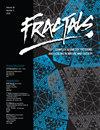自传式错误记忆对神经振荡复杂性的影响
IF 2.9
3区 数学
Q1 MATHEMATICS, INTERDISCIPLINARY APPLICATIONS
Fractals-Complex Geometry Patterns and Scaling in Nature and Society
Pub Date : 2023-11-07
DOI:10.1142/s0218348x23501165
引用次数: 0
摘要
记忆是对过去经历的不完美记录,它使我们能够在现在操作并思考未来。虽然各种各样的因素可能会给错误的回忆信息的机会,但这可能不会发生。这些错误记忆是基于不同的神经认知过程形成的,其潜在机制仍有待进一步研究。考虑到没有发现记忆痕迹时的扩展搜索,我们假设在错误记忆回忆期间,大脑激活的自我相似性一定更高。因此,本研究采用DRM范式设计了一个基于自传式品牌形象的无语言任务。随后,24名健康参与者接受了这项任务的测试,测试期间的大脑活动用32通道脑电图系统记录下来。随后,利用脑电数据的分形维数(FD)估计脑活动模式的自相似性。统计分析显示,与真实记忆记忆相比,虚假记忆记忆的复杂性在额叶区域显著增加。有趣的是,脑电图结果在男女中都是一致的,并且与受试者的回忆准确率和反应时间(RTs)显著相关。本文章由计算机程序翻译,如有差异,请以英文原文为准。
Effect of autobiographical false memory on the complexity of neural oscillations
Memory is an imperfect record of past experiences that enables us to operate in the present and think about the future. Although various factors may give a chance to a false recollection of information that may not occur. These false memories are formed based on various neuro-cognitive processes the underlying mechanism still needs to be well understood. Considering the extended searching when no memory trace is found, we hypothesized that the self-similarities in the brain activations must be higher during false memory recalls. Therefore, a language-free task based on autobiographical brand images was designed using the Deese–Roediger–McDermott (DRM) paradigm. The task was then tested on 24 healthy participants while the brain activities during the test were recorded using a 32-channel EEG system. Subsequently, the self-similarities in the brain activity pattern were estimated by taking the fractal dimension (FD) of the cleaned EEG data. Statistical analysis showed a significant increase in complexity during false memory recalls as compared to true memory recalls prominent in the frontal regions. Interestingly, the EEG findings were consistent in both genders and significantly correlated with subjects’ accuracy rates and reaction times (RTs) to recall.
求助全文
通过发布文献求助,成功后即可免费获取论文全文。
去求助
来源期刊
CiteScore
7.40
自引率
23.40%
发文量
319
审稿时长
>12 weeks
期刊介绍:
The investigation of phenomena involving complex geometry, patterns and scaling has gone through a spectacular development and applications in the past decades. For this relatively short time, geometrical and/or temporal scaling have been shown to represent the common aspects of many processes occurring in an unusually diverse range of fields including physics, mathematics, biology, chemistry, economics, engineering and technology, and human behavior. As a rule, the complex nature of a phenomenon is manifested in the underlying intricate geometry which in most of the cases can be described in terms of objects with non-integer (fractal) dimension. In other cases, the distribution of events in time or various other quantities show specific scaling behavior, thus providing a better understanding of the relevant factors determining the given processes.
Using fractal geometry and scaling as a language in the related theoretical, numerical and experimental investigations, it has been possible to get a deeper insight into previously intractable problems. Among many others, a better understanding of growth phenomena, turbulence, iterative functions, colloidal aggregation, biological pattern formation, stock markets and inhomogeneous materials has emerged through the application of such concepts as scale invariance, self-affinity and multifractality.
The main challenge of the journal devoted exclusively to the above kinds of phenomena lies in its interdisciplinary nature; it is our commitment to bring together the most recent developments in these fields so that a fruitful interaction of various approaches and scientific views on complex spatial and temporal behaviors in both nature and society could take place.

 求助内容:
求助内容: 应助结果提醒方式:
应助结果提醒方式:


